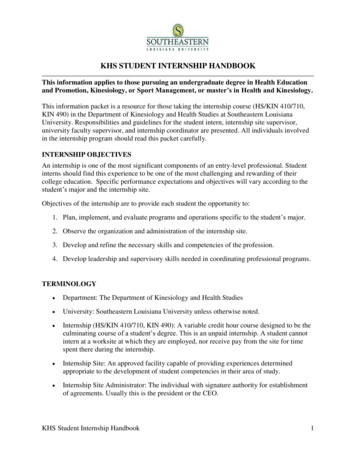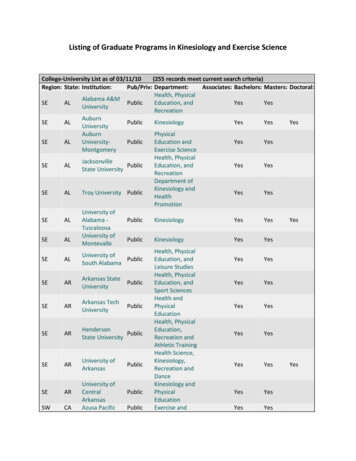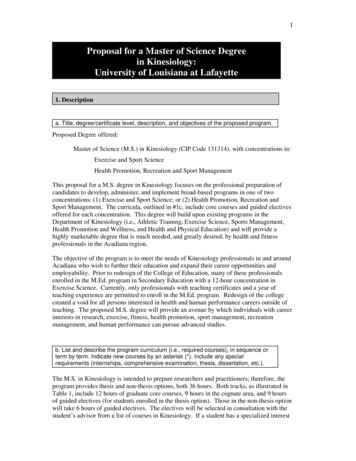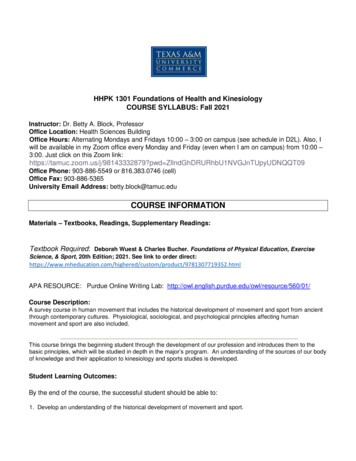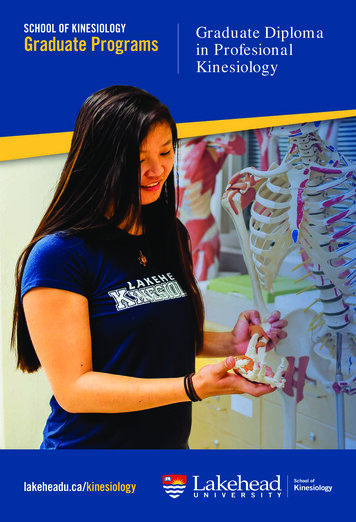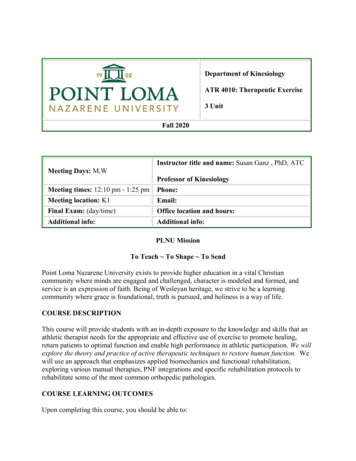
Transcription
Department of KinesiologyATR 4010: Therapeutic Exercise3 UnitFall 2020Instructor title and name: Susan Ganz , PhD, ATCMeeting Days: M,WProfessor of KinesiologyMeeting times: 12:10 pm - 1:25 pmPhone:Meeting location: K1Email:Final Exam: (day/time)Office location and hours:Additional info:Additional info:PLNU MissionTo Teach To Shape To SendPoint Loma Nazarene University exists to provide higher education in a vital Christiancommunity where minds are engaged and challenged, character is modeled and formed, andservice is an expression of faith. Being of Wesleyan heritage, we strive to be a learningcommunity where grace is foundational, truth is pursued, and holiness is a way of life.COURSE DESCRIPTIONThis course will provide students with an in-depth exposure to the knowledge and skills that anathletic therapist needs for the appropriate and effective use of exercise to promote healing,return patients to optimal function and enable high performance in athletic participation. We willexplore the theory and practice of active therapeutic techniques to restore human function. Wewill use an approach that emphasizes applied biomechanics and functional rehabilitation,exploring various manual therapies, PNF integrations and specific rehabilitation protocols torehabilitate some of the most common orthopedic pathologies.COURSE LEARNING OUTCOMESUpon completing this course, you should be able to:
Articulate & teach the physiological response of the body to trauma andinactivity/immobilization.Demonstrate a wide variety of manual and functional therapeutic techniques.Perform objective measures to determine the level of function of a patient, the prognosisfor recovery and the appropriateness of the therapeutic intervention.Outline the indications and contraindications of exercise after injury.Create activity-specific functional progressions with appropriate goals in a therapeuticexercise program.Describe common surgical techniques and implement a postoperative rehabilitation orreconditioning exercise program.Perform movement screening and corrective exercise assessments to restore functionalmovement patterns for safe return to physical activity.Appreciate the importance of functional outcome measures to determine patient healthrelated quality of life.REQUIRED TEXTS AND RECOMMENDED STUDY RESOURCESRequired (you may buy 5th or 6th ed)Prentice, WE. Prentice, WE. Rehabilitation Techniques for Sports Medicine & Athletic Training,5th ed., McGraw-Hill; 2009., 5th ed., McGraw-Hill; 2009. eTextbook Option: ( 55, 14 daymoney-back guarantee);Recommended: Arnheim DD, Prentice WE. Principles of Athletic Training. 13th ed. Boston:McGraw –Hill; 2008.Supplemental Course Reader; Library Resource: Kinesiology Subject Guide: KinesiologyPageCOURSE CREDIT HOUR INFORMATIONIn the interest of providing sufficient time to accomplish the stated Course Learning Outcomes,this class meets the PLNU credit hour policy for a 3 unit class delivered over 15 weeks. Specificdetails about how the class meets the credit hour requirement can be provided upon request.(Based on 37.5 hours of student engagement per credit hour.)In the interest of providing sufficient time to accomplish the stated Course Learning Outcomes,this class meets the PLNU credit hour policy for a 3 unit class delivered over 15 weeks. It isanticipated that students will spend a minimum of 37.5 participation hours per credit hour ontheir coursework. For this course, students will spend an estimated 112.5 total hours meeting thecourse learning outcomes. The time estimations are provided in the Canvas modules.Distribution of Student Learning HoursCategoryOnline Participation in Discussions, Groups, etc.Time Expectation in Hours
Distribution of Student Learning HoursCategoryTime Expectation in HoursReading AssignmentsWritten AssignmentsOther Assignments & Learning ActivitiesQuizzes, SurveysTotal Hours112.5COURSE SCHEDULE AND ASSIGNMENTSQuizzesWe will have various forms of quizzes during the semester (online, partner, mid-class session).ExaminationsUnit examinations will be used to measure your mastery of key aspects of the course ofstudy. Exams will be used both in class and online through eclass. Students traveling for teamassignments must complete exams before travel.Lab Demonstration of Therapeutic ExerciseStudents will be evaluated for competence in the following exercises:1. isometric, isotonic and isokinetic exercise2. eccentric versus concentric versus econcentric exercise3. open versus closed kinematic chain exercise4. elastic, mechanical and manual resistance exercises5. joint mobilization6. plyometrics-dynamic reactive exercise7. proprioceptive neuromuscular facilitation (PNF) for muscular strength/endurance, musclestretching, and improved range of motion8. exercises to improve neuromuscular coordination and proprioception9. passive, active and active-assisted exercise10. cardiovascular exercise, including the use of stationary bicycles, upper body ergometer,treadmill and stair climber11. functional rehabilitation and reconditioning, functional progressions12. sport specific activityFunctional Progression (FP) OR Corrective Exercise Intervention (CE)
For this assignment, you can choose to design either a functional progression or aCorrective Exercise Intervention.The Functional Progression can be based on an upper or lower-extremity injury. Exercisesshould include only those that are functionally-specific to the athlete’s sport or activity. Avariety of exercises should be utilized, with an increase in complexity and a logical, triplanarapproach.If you choose to accomplish the Corrective Exercise Intervention, you should develop asequence of steps to address a specific movement system impairment or postural distortionsyndrome using the NASM’s Corrective Exercise Continuum (I will give you access to CESmaterial PRN).**Please create your exercises using either video, PPT, or using the PDF format on theAthletic Training Clinic’s websiteHere is a good template:For the FP, you must view the Functional Video Digest Series (Gary Gray, PT) most appropriatefor your chosen joint. This is for your benefit and will enhance your treatment approach. Youshould be prepared to share your progression with colleagues. See Appendix 1 for list of videos.Discussion Board ParticipationI have supplemented the course text and lecture materials with current evidence-based medicalliterature. These readings will be provided via electronic access to journal articles andsystematic reviews. It is expected that course material will be read before the scheduled lectureso that informed and lively discussion may be the primary focus of class meetings. The aim ofsupplemental reading is to increase awareness of the variety of thought and approachesconcerning therapeutic exercise, and to keep you current with contemporary practice.After certain readings, and prior to the in-class discussion, you will respond to questions on theDiscussion Board on eclass. At other times, I will also ask you to summarize the key points ofoutside readings by outlining the major points of the article prior to class. You should be readyto discuss these outlines with your colleagues in class, and refine the ideas together throughJigSaw activities.
Final ExamExam: A cumulative review of course Competencies will be evaluated in exam format.Group Rehabilitation ProjectYou will collaborate with a colleague(s) to produce a comprehensive rehabilitation interventionfor a post-surgical case. Your group will present the program in Powerpoint/Prezi format similarto a professional conference symposium. I will invite the Kinesiology department students andfaculty to our symposium. Please note that your work as members of the group will bedisseminated to other students and faculty; although your grade and any other sensitive materialwill not be shared.Topics for Group Project (postoperative rehab programs): Bankart RepairACL with/without meniscal repairLumbar spine disc herniation w/without spondylopathyUCL repair: “Tommy John” reconstructionModified Brostrom repair for Chronic Ankle InstabilityDynamic warmup and flexibility program for a team or group (injury preventionapproach)o e. ACL prevention program, or ankle/knee injury prevention in BKBTRX strength and flexibility programHigh Intensity Interval Training Program (HIIT: Interval Circuit training) forperformance enhancement or prevention of diseaseCorrective exercise interventionASSESSMENT AND GRADING1.2.3.4.5.6.Quizzes not to exceed 5@10 pts eachExaminations 3@100 pts eachDemonstration of Therapeutic Exercise in lab 5@20 pts eachFunctional Progression/Rehab Class (30/20)Participation in Discussion BoardFinal exam/Group Rehab. Project5030010030/2040200TOTAL 750
All assignments are due at the beginning of the class period in which they were assigned.Classes missed due to athletic events, planned family functions or athletic training assignmentsmust be planned and arranged with the professor before class.NOTE: It is your responsibility to maintain your class schedule. Should the need arise to dropthis course (personal emergencies, poor performance, etc.), you have responsibility to followthrough (provided the drop date meets the stated calendar deadline established by theuniversity), not the instructor.ASSESSMENT AND GRADINGNote: Clearly define a grading policy to avoid any confusion concerning expectations. It is mosthelpful if at least two things are present: 1) a point distribution and 2) a grading scale.Student grades will be posted in the Canvas grade book no later than midnight onTuesday of each week beginning in Week Two of this course. It is important to read thecomments posted in the grade book as these comments are intended to help studentsimprove their work. Final grades will be posted within one week of the end of the class.Grades will be based on the following:Standard Grade Scale Based on PercentagesAA 93-100BB 87-89CC 77-79DD 67-69A- 90-92B 83-86C 73-76D 63-66B- 80-82C- 70-72D- 60-62FF Less than 59STATE AUTHORIZATIONState authorization is a formal determination by a state that Point Loma Nazarene University isapproved to conduct activities regulated by that state. In certain states outside California, PointLoma Nazarene University is not authorized to enroll online (distance education) students. If astudent moves to another state after admission to the program and/or enrollment in an onlinecourse, continuation within the program and/or course will depend on whether Point LomaNazarene University is authorized to offer distance education courses in that state. It is thestudent’s responsibility to notify the institution of any change in his or her physicallocation. Refer to the map on State Authorization to view which states allow online (distanceeducation) outside of California.INCOMPLETES AND LATE ASSIGNMENTS
All assignments are to be submitted/turned in by the beginning of the class session when they aredue—including assignments posted in Canvas. Incompletes will only be assigned in extremelyunusual circumstances.PLNU COPYRIGHT POLICYPoint Loma Nazarene University, as a non-profit educational institution, is entitled by law to usematerials protected by the US Copyright Act for classroom education. Any use of those materialsoutside the class may violate the law.PLNU ACADEMIC HONESTY POLICYStudents should demonstrate academic honesty by doing original work and by giving appropriatecredit to the ideas of others. Academic dishonesty is the act of presenting information, ideas,and/or concepts as one’s own when in reality they are the results of another person’s creativityand effort. A faculty member who believes a situation involving academic dishonesty has beendetected may assign a failing grade for that assignment or examination, or, depending on theseriousness of the offense, for the course. Faculty should follow and students may appeal usingthe procedure in the university Catalog. See Academic Policies for definitions of kinds ofacademic dishonesty and for further policy information.PLNU ACADEMIC ACCOMMODATIONS POLICYWhile all students are expected to meet the minimum standards for completion of this course asestablished by the instructor, students with disabilities may require academic adjustments,modifications or auxiliary aids/services. At Point Loma Nazarene University (PLNU), thesestudents are requested to register with the Disability Resource Center (DRC), located in the BondAcademic Center. (DRC@pointloma.edu or 619-849-2486). The DRC’s policies and proceduresfor assisting such students in the development of an appropriate academic adjustment plan (AP)allows PLNU to comply with Section 504 of the Rehabilitation Act and the Americans withDisabilities Act. Section 504 (a) prohibits discrimination against students with special needs andguarantees all qualified students equal access to and benefits of PLNU programs andactivities. After the student files the required documentation, the DRC, in conjunction with thestudent, will develop an AP to meet that student’s specific learning needs. The DRC willthereafter email the student’s AP to all faculty who teach courses in which the student is enrolledeach semester. The AP must be implemented in all such courses.If students do not wish to avail themselves of some or all of the elements of their AP in aparticular course, it is the responsibility of those students to notify their professor in thatcourse. PLNU highly recommends that DRC students speak with their professors during the firsttwo weeks of each semester about the applicability of their AP in that particular course and/or ifthey do not desire to take advantage of some or all of the elements of their AP in that course.PLNU ATTENDANCE AND PARTICIPATION POLICY
Regular and punctual attendance at all synchronous class sessions is considered essential tooptimum academic achievement. If the student is absent for more than 10 percent of classsessions (virtual or face-to-face), the faculty member will issue a written warning of deenrollment. If the absences exceed 20 percent, the student may be de-enrolled without noticeuntil the university drop date or, after that date, receive the appropriate grade for their work andparticipation. In some courses, a portion of the credit hour content will be deliveredasynchronously and attendance will be determined by submitting the assignments by the posteddue dates. See Academic Policies in the Undergraduate Academic Catalog. If absences exceedthese limits but are due to university excused health issues, an exception will be granted.Asynchronous Attendance/Participation DefinitionA day of attendance in asynchronous content is determined as contributing a substantive note,assignment, discussion, or submission by the posted due date. Failure to meet these standardswill result in an absence for that day. Instructors will determine how many asynchronousattendance days are required each week.SPIRITUAL CAREPlease be aware PLNU strives to be a place where you grow as whole persons. To this end, weprovide resources for our students to encounter God and grow in their Christian faith.If students have questions, a desire to meet with the chaplain or have prayer requests you cancontact the Office of Spiritual DevelopmentUSE OF TECHNOLOGYIn order to be successful in the online environment, you'll need to meet the minimum technologyand system requirements; please refer to the Technology and System Requirements information.Problems with technology do not relieve you of the responsibility of participating, turning inyour assignments, or completing your class work.
Student grades will be posted in the Canvas grade book no later than midnight on Tuesday of each week beginning in Week Two of this course. It is important to read the comments posted in the grade book as these comments are intended to help students improve their work. Final grades will be posted within one week of the end of the class.
